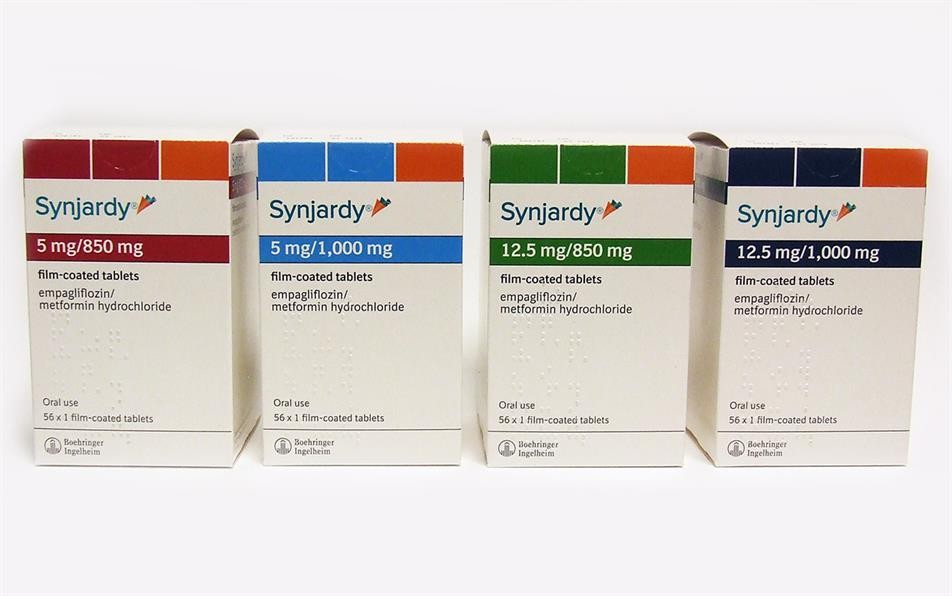
Contents
Synjardy (empagliflozin and metformin)
Synjardy is a prescription medicine for Type 2 Diabetes Mellitus. It may be used alone or with other medications.
Synjardy belongs to a class of drugs called Antidiabetics, Biguanides; Antidiabetics, SGLT2 Inhibitors.
Synjardy’s safety and effectiveness have not been established in children younger than 18 years old.
What are the side effects of Synjardy?
LACTIC ACIDOSIS
Metformin-associated lactic acidosis can have severe symptoms, including death. It is often accompanied by nonspecific symptoms such as malaise, myalgias, respiratory distress, somnolence, and abdominal pain. Elevated blood lactate levels, increased lactate/pyruvate ratio, and metformin plasma levels >5 mcg/mL characterize metformin-associated lactic acidosis.
Risk factors for metformin-associated lactic acidosis include renal impairment, use of carbonic anhydrase inhibitors, age 65 years old or greater, radiological procedures with contrast, surgery, hypoxic states, excessive alcohol intake, and hepatic impairment.
To reduce the risk of metformin-associated lactic acidosis, refer to the full prescribing information.
If metformin-associated lactic acidosis is suspected, discontinue Synjardy and seek medical attention. Hemodialysis is recommended.
Synjardy may cause serious side effects including:
- hives,
- difficulty breathing,
- swelling of face, lips, tongue, or throat,
- burning or painful urination,
- frequent or urgent urination,
- pink or bloody urine,
- little or no urination,
- unusual vaginal discharge, burning, itching, or odor,
- redness, itching, swelling of the penis,
- unusual discharge from the penis,
- pain, redness, swelling in or around genital or anal area,
- fever,
- feeling unwell,
- sudden sweating,
- shaking,
- fast heartbeat,
- hunger,
- blurred vision,
- dizziness,
- tingling hands or feet,
- thirst,
- increased urination,
- confusion,
- drowsiness,
- flushing,
- rapid breathing,
- fruity breath odor,
- vomiting,
- diarrhea,
- heavy sweating,
- dry mouth,
- thirst,
- lightheadedness, and
- fainting
If you experience any of the mentioned symptoms, seek medical help immediately.
The most common side effects of Synjardy include:
Report any bothersome side effects to your doctor.
These are not all the possible side effects of Synjardy. For more information, consult your doctor or pharmacist.
Contact your doctor for medical advice regarding side effects. You may report side effects to FDA at 1-800-FDA-1088.
What is the dosage for Synjardy?
Prior To Initiation Of Synjardy
- Assess renal function before starting Synjardy.
- In patients with volume depletion, correct this condition before initiating Synjardy.
Recommended Dosage And Administration
- Individualize the starting dose of Synjardy based on the patient’s current regimen:
- Switch to Synjardy containing empagliflozin 5 mg if on metformin HCl;
- Switch to Synjardy containing metformin HCl 500 mg if on empagliflozin;
- Switch to Synjardy containing the same total daily doses of each component if already on empagliflozin and metformin HCl.
Dosage Recommendations In Patients With Renal Impairment
- Do not initiate Synjardy if eGFR is less than 45 mL/min/1.73 m 2 due to the metformin component.
- Synjardy is contraindicated if eGFR is less than 30 mL/min/1.73 m 2 or in patients on dialysis.
Discontinuation For Iodinated Contrast Imaging Procedures
Discontinue Synjardy before an iodinated contrast imaging procedure if eGFR is less than 60 mL/min/1.73 m 2 , patient has a history of liver disease, alcoholism or heart failure, or if intra-arterial iodinated contrast will be administered. Re-evaluate eGFR 48 hours after the imaging procedure and resume Synjardy if renal function is stable.
QUESTION
What drugs interact with Synjardy?
Table 4 Clinically Relevant Interactions with Synjardy
| Carbonic Anhydrase Inhibitors | |
| Clinical Impact | Topiramate or other carbonic anhydrase inhibitors may cause a decrease in serum bicarbonate and induce non-anion gap, hyperchloremic metabolic acidosis. |
| Intervention | Using these drugs with Synjardy may increase the risk of lactic acidosis. Monitor these patients more frequently. |
| Drugs that Reduce Metformin Clearance | |
| Clinical Impact | Drugs that interfere with renal elimination of metformin, such as ranolazine, vandetanib, dolutegravir, and cimetidine, could increase systemic exposure to metformin and the risk of lactic acidosis. |
| Intervention | Consider the benefits and risks of concomitant use. |
| Alcohol | |
| Clinical Impact | Alcohol potentiates metformin’s effect on lactate metabolism. |
| Intervention | Advise patients against excessive alcohol intake while taking Synjardy. |
| Diuretics | |
| Clinical Impact | Empagliflozin with diuretics increases urine volume and frequency of voids, potentially leading to volume depletion. |
| Intervention | Assess volume status and renal function before initiating Synjardy. Correct volume depletion if present. Monitor for signs and symptoms of volume depletion and renal function after starting therapy. |
| Insulin or Insulin Secretagogues | |
| Clinical Impact | Combining empagliflozin with insulin secretagogues or insulin increases the risk of hypoglycemia. Metformin also increases the risk of hypoglycemia when combined with insulin or an insulin secretagogue. |
| Intervention | Lower doses of insulin secretagogues or insulin may be required when coadministered with Synjardy to reduce the risk of hypoglycemia. |
| Drugs Affecting Glycemic Control | |
| Clinical Impact | Certain drugs tend to produce hyperglycemia and may lead to loss of glycemic control. |
| Intervention | Monitor patients closely for glycemic control when administering such drugs with Synjardy. Monitor for hypoglycemia when withdrawing such drugs from patients on Synjardy. |
| Positive Urine Glucose Test | |
| Clinical Impact | SGLT2 inhibitors increase urinary glucose excretion, resulting in positive urine glucose tests. |
| Intervention | Do not rely on urine glucose tests to monitor glycemic control in patients taking SGLT2 inhibitors. Use alternative methods instead. |
| Interference with 1,5-anhydroglucitol (1,5-AG) Assay | |
| Clinical Impact | Measuring 1,5-AG is not reliable for assessing glycemic control in patients taking SGLT2 inhibitors. |
| Intervention | Do not use the 1,5-AG assay to monitor glycemic control. Employ alternative methods instead. |
Is Synjardy safe to use while pregnant or breastfeeding?
- Inform pregnant patients and those of reproductive potential about potential fetal risks associated with Synjardy.
- Patients should report pregnancies to their physicians promptly. Breastfeeding is not recommended while taking Synjardy.


